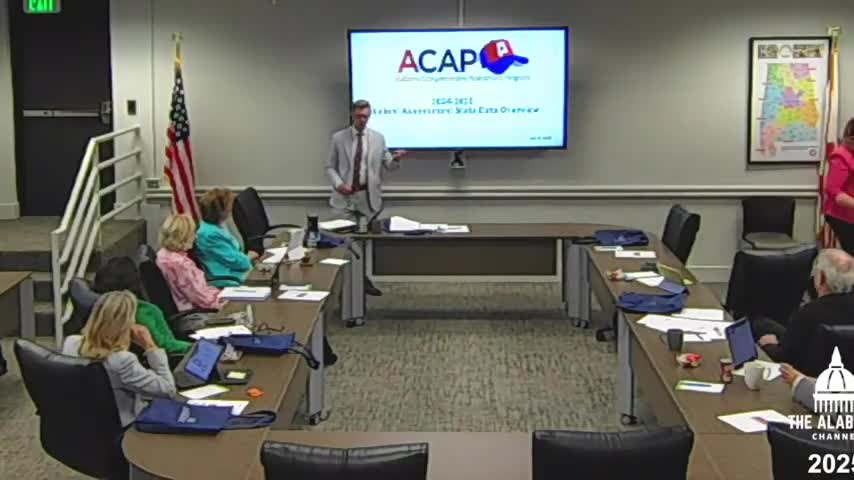Department reports unverified 2024–25 assessment snapshot: reading gains, middle‑grade math concerns, ACT discussion
October 17, 2025 | Alabama State Department of Education, State Agencies, Executive, Alabama
This article was created by AI summarizing key points discussed. AI makes mistakes, so for full details and context, please refer to the video of the full meeting. Please report any errors so we can fix them. Report an error »

The Alabama State Department of Education presented an unverified statewide snapshot of 2024–25 assessment results, highlighting fewer students in the lowest achievement levels in reading and math, across‑grade reading gains in several grades and persistent challenges in middle‑grade math.
The department stressed that the data released to the board were unverified statewide figures; districts and schools have an August verification window and the department said district/school‑level verified data would follow. The department reported drops in the percentage of students at Level 1 (well below proficiency) in reading and math and increases in state proficiency (levels 3 and 4) in reading for most grades. For example, reading proficiency statewide in tested grades rose modestly from 2024 to 2025 in the department’s unverified figures.
Department presenters said the improvements reflect targeted investments in core instruction, high‑quality instructional materials and interventions for lowest‑performing students. They noted, however, that while many students moved out of the lowest level, too few moved from Level 2 (still below proficiency) into proficiency levels in math. Middle‑grade math (notably seventh and eighth grades) showed anomalous patterns: some grades had large drops at Level 1 but those gains did not translate into proficiency-level increases.
Department staff explained part of the middle‑grade math complexity: by eighth grade many high‑performing students have moved into accelerated courses (algebra) and the mandated test does not change to align with that course, which complicates interpretation of aggregated grade‑level math results.
The department also reviewed other assessment-related items: a NAEP (National Assessment of Educational Progress) sample will be taken in the coming year (principals selected for NAEP are notified in mid‑July and only a small percentage of schools and students are sampled), science testing results showed some gains, and the state’s English‑language‑learner (ELL) population increased from about 41,000 to about 51,000 in recent years, the department said.
On high‑school accountability testing, the department reported a small composite ACT decline (a tenth of a point) and reiterated that a separate state conversation about the future of the high‑school summative assessment is underway. Staff noted a statutory option ("option B" diploma pathway) recently adopted at the state level will, when widely chosen, remove the ACT score from the state a–f high‑school accountability calculation; the department said that could affect incentives for some students to take the ACT and could factor into districts’ preferences for the state’s high‑school accountability instrument.
The department said it will provide district and school level verified data to the board after local validation work is completed (district verification expected by early August).
The department stressed that the data released to the board were unverified statewide figures; districts and schools have an August verification window and the department said district/school‑level verified data would follow. The department reported drops in the percentage of students at Level 1 (well below proficiency) in reading and math and increases in state proficiency (levels 3 and 4) in reading for most grades. For example, reading proficiency statewide in tested grades rose modestly from 2024 to 2025 in the department’s unverified figures.
Department presenters said the improvements reflect targeted investments in core instruction, high‑quality instructional materials and interventions for lowest‑performing students. They noted, however, that while many students moved out of the lowest level, too few moved from Level 2 (still below proficiency) into proficiency levels in math. Middle‑grade math (notably seventh and eighth grades) showed anomalous patterns: some grades had large drops at Level 1 but those gains did not translate into proficiency-level increases.
Department staff explained part of the middle‑grade math complexity: by eighth grade many high‑performing students have moved into accelerated courses (algebra) and the mandated test does not change to align with that course, which complicates interpretation of aggregated grade‑level math results.
The department also reviewed other assessment-related items: a NAEP (National Assessment of Educational Progress) sample will be taken in the coming year (principals selected for NAEP are notified in mid‑July and only a small percentage of schools and students are sampled), science testing results showed some gains, and the state’s English‑language‑learner (ELL) population increased from about 41,000 to about 51,000 in recent years, the department said.
On high‑school accountability testing, the department reported a small composite ACT decline (a tenth of a point) and reiterated that a separate state conversation about the future of the high‑school summative assessment is underway. Staff noted a statutory option ("option B" diploma pathway) recently adopted at the state level will, when widely chosen, remove the ACT score from the state a–f high‑school accountability calculation; the department said that could affect incentives for some students to take the ACT and could factor into districts’ preferences for the state’s high‑school accountability instrument.
The department said it will provide district and school level verified data to the board after local validation work is completed (district verification expected by early August).
View full meeting
This article is based on a recent meeting—watch the full video and explore the complete transcript for deeper insights into the discussion.
View full meeting
